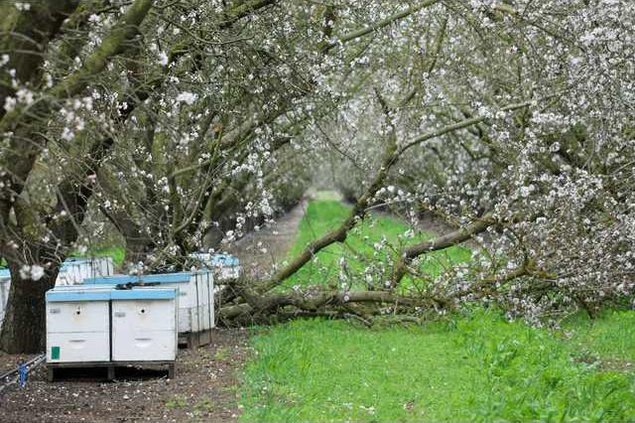Richard Phillips has lost nearly a hundred blooming almond trees just in the last three days. He is hoping that today and the rest of the week, there will be no repeat of Friday’s strong wind that sent hundreds of the nut-producing staple all over Manteca and surrounding areas falling like sticks to the ground.
“Lots of downed trees,” said the lifetime farmer who not only grows almonds but runs a huller as well on South Union Road.
When he visited farmer friends in South Manteca along South Airport Way over the weekend, he saw the same devastation in their orchards. Like him, they are also worried about what this week’s weather will further bring upon their nut crop this year, he said.
Along South Austin Road, the sorry situation is the same. One particular orchard on the south side of Sedan has almond trees in full bloom uprooted with the white blossoms scattered on the neatly trimmed green carpet of grass running like a dignitary’s red carpet between the rows. In contrast, the orchard on the opposite side of Sedan has not suffered the same fate. For one thing, the trees are much younger than their counterparts across the road.
An Almond Board of California report on the “Economics of Growing Almonds” based on the 2011 crop indicated 1,803 pounds of almonds was the average per acre yield for the Northern San Joaquin Valley. Spacing can range anywhere from 90 to 198 trees per acre. If an older orchard has 22 foot by 22 foot planting that translates to 90 trees per acre. That translates into 20.33 pounds per year. If almond priced are at $3 per pound per farmer the loss of one tree represents not just $60 this year but $60 for every subsequent year the tree was expected to produce. Given the same study shows orchards in this area typically netted $715 per ace in 2011, the loss of a number of trees can be significantly financially.
Many of the older trees – 20 years and up – are “vulnerable” to the weather, Phillips said.
Such is the case with many of their trees, he said. “They’re getting old. A little wind and they fall right over.”
The youngest in their orchards were planted “about 1998,” he said. The others are 25 to 26 years old; hence, are getting close to 30 years which is about the life-span of almonds.
Randy Grimm, a young almond grower in Manteca, is feeling fortunate.
“I didn’t lose any tree. My trees are young enough so I had no problems,” he said with relief.
“We’re pretty much in good shape.”
His acreage along Veritas Avenue are not even 10 years old. A much smaller spread south of Woodward Avenue right next to the new residential developments on Oleander Avenue was just planted a little more than a month ago.
His brother-in-law, Steve Brocchini of Manteca who is also an almond grower, was not as fortunate though. “He lost some of his trees,” Grimm said.
While the orchard farmers are worried about losing trees at the peak of the bloom season, their problem does not stop there. Those that are left standing and were spared by the wind gusts remain vulnerable. As Grimm pointed out, “the winds are hard on the blooms,” which is why the farmers are keeping a close eye on the weather the rest of the week while hoping and praying that it does not get any worse.
“When I was a kid, I used to love seeing the wind,” noted Phillips whose nut crop was also devastated over a decade ago under similar destructive windy weather plus rain.
Driving around, he sees all the signs, “Pray for Rain,” he said with a chuckle laced with a bit of irony. “Now, they are saying, ‘pray to stop the rain’.”
He quickly added, thinking of his farmer friends in vulnerable low areas in rural south Manteca, “Let’s hope it doesn’t flood.”





